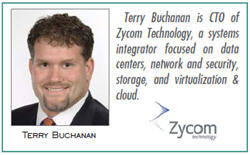Why You Need To Know About The 3 Kinds Of VDI
By Jay McCall, Business Solutions magazine
Virtualization is the foundation for your cloud services offering.
 VVDI (virtual desktop integration) has become a buzzword in the IT networking community, and it’s even become somewhat controversial. To help shed light on this topic, I spoke with Terry Buchanan, CTO of systems integrator Zycom Technology. Zycom is headquartered in Kingston, Ontario and has five branch offices. The integrator has 40 fulltime employees and 50 part-time employees, and it has four core business practices — data centers, network and security, storage, and virtualization & cloud. Its virtualization and cloud practice comprises 40% of Zycom’s annual revenue.
VVDI (virtual desktop integration) has become a buzzword in the IT networking community, and it’s even become somewhat controversial. To help shed light on this topic, I spoke with Terry Buchanan, CTO of systems integrator Zycom Technology. Zycom is headquartered in Kingston, Ontario and has five branch offices. The integrator has 40 fulltime employees and 50 part-time employees, and it has four core business practices — data centers, network and security, storage, and virtualization & cloud. Its virtualization and cloud practice comprises 40% of Zycom’s annual revenue.
What are the primary types of virtualization services you sell?
- Virtual DaaS (desktops as a service), which we call private cloud personal computing or PC2
- BYOD (bring your own device)/BYOC (bring your own computer) assessments
- Application virtualization
- Private cloud assessment, deployment, and optimization
- Server virtualization
- Storage virtualization
- User virtualization
- Virtual data recovery and disaster recovery
Is DaaS the same as VDI?
There are actually three forms of VDI, which causes a lot of confusion with end users as well as vendors and channel companies. Here is an explanation of the three forms of VDI:
Server Based Computing (SBC) — SBC gives users the ability to run multiple desktop sessions on one server. Most commonly associated with Windows-based server technology, this method increases ROI and reduces TCO (total cost of ownership) through economies of scale by increasing the device-to-user ratio. For example, 1 server hosts 50-plus users instead of the traditional ratio of 1 PC to 1 user. Technologies such as Citrix XenApp or Microsoft Remote Desktop Service (RDS) can be used in SBC implementations.
Hosted Virtual Desktops (HVD) — This virtualization setup gives you the ability to run a virtual PC (vPC) device within a host hypervisor or on a blade. It provides greater computing power for more complex apps that are not suitable for an SBC desktop (e.g. situations where you don’t want to break the client/server model). Provisioning technologies can enable one disk image to be used for multiple vPCs, saving on storage costs and minimizing updates. It also provides alternative solutions for remote access, high availability, and disaster recovery (DR) needs. Citrix XenDesktop and VMware View are two examples of virtualization software used for HVD implementations. One of the upsides with HVD is that it pushes the ratio of virtual PCs to hosts to 150:1, which creates a significant cost savings compared with the traditional client/server model.
Application Virtualization — This is used to decouple an application from the client operating system into a package, which allows for incompatible applications to coexist on the same client endpoint. It removes the requirement to install each application on each client endpoint and enables delivery of a single package to multiple desktops or server operating systems. Citrix Streaming, Microsoft App-V, and VMware ThinApp are examples of applications used in application virtualization.
Where does the cloud fit into your virtualization model?
Cloud inevitably is a process or cultural change in the way we leverage and deliver virtualized assets. When we sell PC2 solutions using HVD infrastructure, for example, our clients have the option of deploying DaaS as a private cloud in-premise service delivery model or a hosted private-cloud service delivery model within our infrastructure as a service (IaaS) data centers. In short, our clients can choose which location of their private cloud personal computing delivery model makes the most sense for them. We help integrate the customer’s HVD infrastructure and manage it with private cloud management suites from either Embotics V-Commander or VMware’s vCloud Director.
